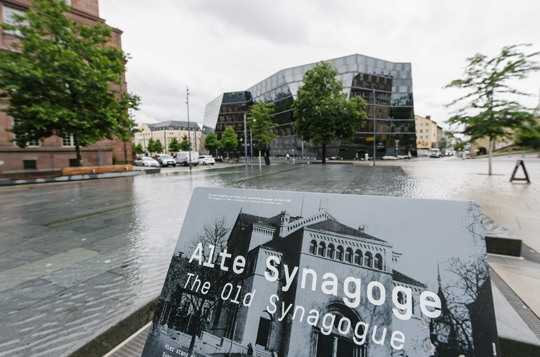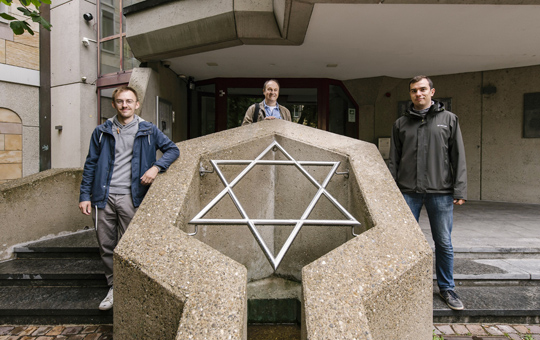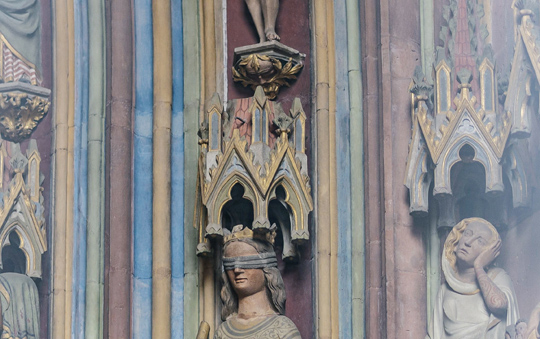An Audio Walk through History
Freiburg, Jun 23, 2020
Dark, heavy clouds drift over Freiburg, leaving behind a trace of fine drizzle. A small group made up of two history students and a historian from the University of Freiburg, aren't letting the damp weather put them off introducing the website „schalomfreiburg.de“, even though they're in the middle of town rather than at a PC. This audio walk is the result of an unusual seminar on Jewish history and present life of the city of Freiburg that took place in the Summer Semester of 2019. The project was commissioned by the Jewish community of Freiburg and financed by the city's Anniversary Fund.
 The pool of water at the Platz der Alten Synagoge traces the floor plan of the Jewish house of prayer destroyed by the Nazis in November 1938. Photo: Patrick Seeger
The pool of water at the Platz der Alten Synagoge traces the floor plan of the Jewish house of prayer destroyed by the Nazis in November 1938. Photo: Patrick Seeger
As good a place as any to start is the entrance to Collegiate Building I, flanked by Homer and Aristoteles. A photo of the bronze statues of the ancient intellectual greats is used for the heading "Universität im Nationalsozialismus" ("The University during the National Socialist Period") – a dark chapter of Nazi terror in Freiburg. A short audio package can be called up on a smart phone. It tells the story of how Jewish and other members of the university community were systematically ostracized and persecuted.
Dr. Heinrich Schwendemann of the University of Freiburg explains that this audio piece is one of a total of 28 put together by Freiburg students who took part in a seminar. A former Freiburg history student, Julia Wolrab, came up with the concept of a virtual audio tour called "schalomfreiburg.de." Wolrab is currently managing director of the Berlin agency, "past[at]present." Defined by its work, her team is at the interface between research and the public. Wolrab's colleagues, who have completed the Master's program "Public History" at Berlin's Free University (FU), have edited the texts and illustrated them. They also produced the audio edition and programmed the website. Informative, small images indicate the topics of the accompanying stories.
 In front of the Freiburg synagogue, Lukas Schuwald, Heinrich Schwendemann, and Maximilian Brandl (from left to right) present an audio walk stop. Photo: Patrick Seeger
In front of the Freiburg synagogue, Lukas Schuwald, Heinrich Schwendemann, and Maximilian Brandl (from left to right) present an audio walk stop. Photo: Patrick Seeger
Flexible route
The components provide new and interesting perspectives. They lend insight into the history of the Jewish community, describe antisemitism, the fate of businesspeople great and small, and of the Jewish middle class in Freiburg. The issues of deportation, the pogrom of the "Night of the Broken Glass" in 1938, and the reparations after 1945 each have their own chapter. All the audios have a map that goes with them, which provides locations. The students discussed the topics in working groups, prepared reports, and ultimately determined what should be included in the audio walk. Schwendemann says, "The work creates a bridge for imparting local history intermedially and interactively.
He continues, saying that tour's intent is not to follow a fixed route through the city. "It can be varied according to interest, available time, and location," says Schwendemann. Stories and anecdotes rather than monuments and plaques call on listeners to remember and consider current controversies, such as the debate about the "Platz der Alten Synagoge." "They are noticeable to anyone walking through Freiburg with their eyes and ears open," Schwendemann adds. The audio walks are user-friendly, free of charge, and directed at anyone who's interested – including young people, young adults, and tourists.
The remarkable life of a Freiburg native provides the content of the audio piece called, "Der aufrechte Stadtrat Robert Grumbach" ("The Upright City Councilor Robert Grumbach"). A "stolperstein" ("stumbling stone") in Günterstalstraße 47 is a memorial to the Jewish, social democrat council member. The narrator describes the pressure placed on the successful lawyer and city councilor until he and his wife were deported to Gurs. After being liberated by the allies, the Grumbachs returned to Freiburg. He went back to work again as a lawyer, was committed to cultural causes, and died highly honored at the age of eighty-five. History student Lukas Schuwald researched and wrote the script. Jewish history was a completely new topic for him. "I'd never heard of Grumbach before, even though I'm a native of Freiburg," he says. Now, when Schuwald passes audio walk sites, he feels as if he's in the midst of Jewish history.
 The blindfolded figure of Synagoga is used to personify Judaism in the Freiburg Minster. Photo: Patrick Seeger
The blindfolded figure of Synagoga is used to personify Judaism in the Freiburg Minster. Photo: Patrick Seeger
Blindfolded and with broken Torah scrolls
The audio walk takes a step back into the Middle Ages in the vestibule of the Freiburg Minster. The main entrance is still cordoned off with a barrier because of the corona pandemic. But the figures are still visible. The future historian Maximilian Brandl, wrote the text for the audio at this site. He refers to the blindfolded Synagoga, who personifies the embodiment of Judaism. In her hand she holds broken Torah scrolls. She's flanked by foolish virgins with lowered amphora. Virtuous maidens stand alongside her opposite, who is dressed in a blue robe with a cross-topped staff in her right hand and a chalice in her left, alluding to the supper of Ecclesia. She is the embodiment of the Christian church. "There it quickly becomes clear who was praised and who was criticized," says Brandl.
Another stop is the "Rees" leather shop on Schusterstraße 23. On the website, the audio is entitled "Lederwarenhändler Max Mayer" ("Leather Goods Merchant, Max Mayer"). It reveals the story of the aryanizing of the former leather shop that's been recorded in the novel, "Der kleine Händler, der mein Vater war" ("A Small Merchant Who Was My Father"), which was written by Mayer's daughter, Lotte Paepke. Schwendemann remembers that by telling the story digitally, the seminar went far beyond purely academic work, which caused some challenges. Painstakingly researched reports had to be squeezed into digital format. Brandl elaborates, "We didn't have much space so we had to keep it short and sweet, yet maintain accuracy while condensing."
Contemporary witnesses
Julia Wolrab contributed interviews with six people from Freiburg who are witnessing Jewish life in the city today. The pieces deal with Jewish identity, what goes on in the synagogue, and a look into the "Privatarchiv der Jüdischen Geschichte" ("Private Archive of Jewish History") of the journalist, Bernd Serger. Another, an interview with Irina Katz of the Jewish community of Freiburg, tells of going away, arriving, and present-day antisemitism. "The interviewees provide answers and a very personal complement to many questions that arise in the audio pieces," says Wolrab, adding that at the moment, the walks are limited to the city center. Otherwise, there would've been too much to do. "But the project can be expanded at any time," Wolrab says.
Eva Opitz

